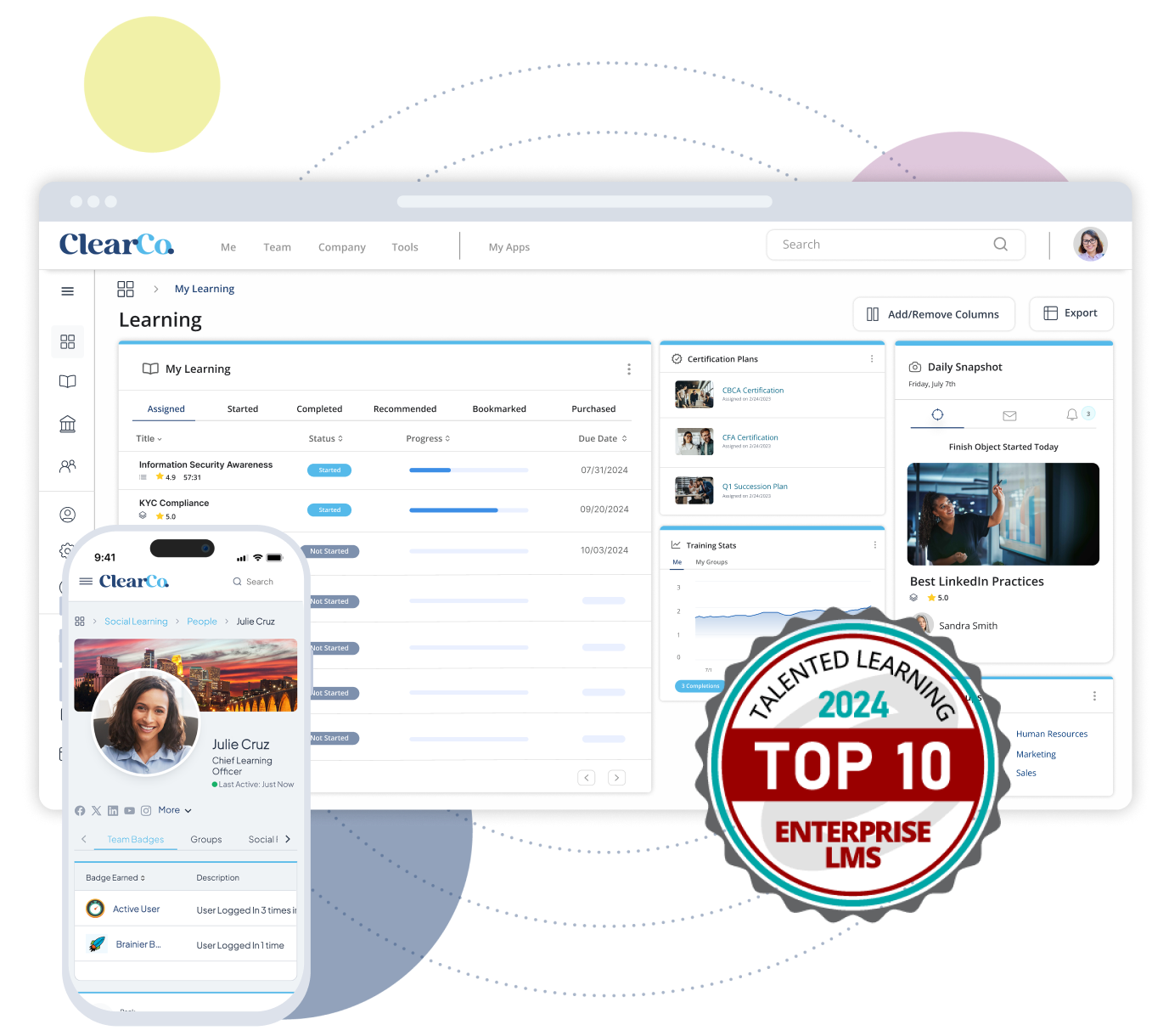Are your learning and development (L&D) programs successful? Are your employees completing courses and acing quizzes? Are they truly gaining new skills and applying them on the job? Does L&D have a positive impact on recruitment, engagement, and retention?
Tracking the right learning and development KPIs can mean the difference between guessing and knowing the impact of your efforts. To figure out if your L&D initiatives are delivering results, you first need to define what success looks like. And in business, that means identifying and tracking the key performance indicators (KPIs) that tie L&D to organizational goals.
We’ll walk you through the must-track L&D KPIs, why they matter, and how they ensure your efforts create real, measurable impact. By the end, you’ll have a roadmap for improving L&D programs, taking them from just up and running to undeniably effective.
Why Should I Use L&D KPIs?
More than 90% of L&D leaders agreed that effective training and development programs improve employee retention. LinkedIn research found that 100% of companies that are “career development champions” are achieving positive results like increased internal mobility and skills acquisition. Do you know if your L&D programs are having a similar effect?
If not, now is the time to change that. Your company’s employee training and development initiatives have arguably never been more important than today. Employees’ skills are quickly becoming outdated — the World Economic Forum estimates that by 2030, 39% of current skills will be affected. Around half of HR professionals say hiring workers with the right mix of skills has been difficult, so companies are already having enough trouble finding candidates.
At the same time, employees are more than willing to learn new skills. In fact, they’re seeking those opportunities — 52% would leave their job for one with continuous L&D. That’s why there’s never been a better time to take control of employee learning and gain a true understanding of its impact.
Without reliable data, you can only guess, and guesswork doesn’t lead to growth. It could even mean resources wasted on training that isn’t useful or programs that don’t address skills gaps. You also miss chances to foster employees’ strengths and guide them toward leadership positions or other internal promotions.
A disconnect between L&D programs and real results is frustrating for everyone. Your efforts to set up programs go unnoticed, employee performance doesn’t improve, and leaders can’t determine return on investment (ROI). On the other hand, tracking training and development KPIs makes all the difference.
Learning and development KPIs give you real insight into what’s working and what’s not so that programs actually work for your employees. L&D becomes more targeted, resources are used efficiently, and you have the data to prove the value of training to stakeholders. With the right KPIs, you can connect learning and development to real outcomes, taking it from a nice perk to a powerful business strategy.
10 Training and Development KPIs To Track
Look at a selection of important learning and development KPIs to monitor your company’s L&D trends, going beyond surface-level stats for a more nuanced understanding of program performance. Let’s dig into 10 key metrics to track and why they matter.
1. Training Completion Rates
Program or course completion rates measure the percentage of employees who finish assigned training courses within a set timeframe. It’s a baseline metric to measure participation, telling you how many employees are engaging with your training initiatives.
This is a fairly common training and development KPI, but it’s incredibly useful. It tells you whether or not employees find the content engaging and enables you to pinpoint areas where participants are dropping off. Do they tend to quit halfway through, or are few employees starting the course in the first place?
A low completion rate might indicate issues with course content, scheduling, or employee motivation. A high rate suggests that learners are engaged and committed to their professional development. Compare rates across modules, departments, and more to dig even deeper.
2. Knowledge Retention
It’s one thing for employees to attend or complete training, but another for them to actually retain the information. Knowledge retention rate evaluates just how much information your employees are retaining, usually measured via follow-up assessments or quizzes. This KPI helps you understand your L&D initiatives’ long-term impact on job performance.
If retention rates are low, it may suggest that the material is too complex or is being delivered ineffectively. It could also indicate a lack of reinforcement in the workplace — few chances to practice the new skill. If it’s the opposite, you can rest assured that your learning methods are working.
Strong knowledge retention translates directly into skills employees can apply on the job, making this metric essential for determining the value of your programs. After all, if learning doesn’t stick, the effort and resources spent on training are wasted.
3. Time-to-Competency
Time-to-competency measures how quickly new hires or existing employees become proficient in their roles after completing training. Much like Knowledge Retention Rate, this L&D KPI is crucial for evaluating the effectiveness of your training methods and content. It’s especially valuable to know for roles with steep learning curves.
If this metric is too high, it could indicate that your learning materials are unclear or outdated. It might also mean that the delivery methods aren’t working, and you need to explore new ways of presenting information.
A shorter time-to-competency means employees are ready to deliver results faster, driving efficiency across teams. It also directly impacts employee satisfaction and confidence on the job. That’s no surprise — Gallup research has long shown that understanding expectations is key for employee engagement.
4. Learner Engagement
Learner engagement tells you how much employees actively participate during training via interactive modules, discussions, or quiz responses. This metric gives you insight into learners’ level of commitment and interest in the subject matter.
A low engagement rate might mean that employees aren’t interested in the topic, or the course is hard to access or tedious. A high engagement rate tells you the course is relevant to your people and presented in a format that works for them.
The more engaged your learners, the more likely they are to absorb and apply new knowledge as they work. That leads to improved performance and more creative problem-solving.
5. Employee Productivity Post-Training
One of the most direct indicators of training success is its impact on productivity. If employees are acquiring new skills via your L&D efforts, it should reflect in their output or work quality. Compare productivity before and after training programs are completed in order to determine if they actually worked. When you do see that increased productivity, you get justification for investments in training, and you contribute to business goal achievement.
6. Promotion and Career Progression Rates
A goal of employee development is often to increase internal mobility rates, whether through promotions or other forms of career advancement. This KPI measures whether your L&D initiatives are accomplishing that by looking at internal movement over a defined period of time. It tells you whether your programs are working and if your company is committed to internal growth.
A high rate shows that your L&D efforts are successfully preparing employees for more senior roles, fostering a culture of growth and retention. A low rate of internal mobility might tell you that either your career development strategies or your promotion practices might need a revamp to ensure there are clear, attainable pathways to progress.
7. Training ROI
Measuring the ROI of your training programs tells you how much value they deliver compared to what was spent on them. This is a broad KPI, which can be calculated by weighing performance improvements, productivity increases, and retention rates against the costs of implementing and delivering L&D.
Training ROI tells you whether or not programs are worth the investment, but also their impact on business outcomes. It helps you build a solid case for future L&D budgets and identify the programs that deliver the most value. Your L&D strategies should always aim for measurable, tangible outcomes, and ROI serves as the proof in the pudding.
8. Skills Gap Analysis Results
Analyzing skills gaps shows you whether employees have the skills to meet your company’s needs now and in the future. When you can see the difference between the current competencies of your workforce and the skills they’ll need to take your business forward, your HR and L&D teams can pinpoint priority training needs.
Knowing your skills gaps means you can also support proactive talent development, ensuring that your people are equipped with the skills they need to meet future challenges.
Dig Into L&D ROI
Get the ebook to learn more about the ROI of L&D programs.
9. Session Feedback and Satisfaction Scores
If you’re using software like a learning management system (LMS) to manage your L&D programs, you can easily capture immediate feedback from your employees. Did they find the content relevant and useful? Did they like the course format, or do you need to explore other delivery methods?
High satisfaction scores indicate that employees are satisfied with courses and delivery, and consistent feedback gives you information about where you can make things better. When you keep a close eye on L&D feedback, you can ensure your programs are always engaging and meeting the learning needs of your people.
10. Turnover Rates Post-Training
We’ve mentioned that L&D is a huge factor in employee turnover. Measuring turnover before and after training programs tells you how it influences employees’ feelings of loyalty. Most people, especially younger generations, say development opportunities are a top reason both for staying at their companies and for taking new jobs. More than 90% of L&D leaders agree.
A decline in turnover post-training suggests that your development efforts are boosting employee engagement, satisfaction, and commitment as anticipated. If turnover isn’t impacted or increases, you may need to address more than just access to training. It might indicate a larger disconnect between your people and company culture or growth opportunities.
How To Start Tracking L&D KPIs
While some organizations have well-defined initiatives, many programs are informal. Even if training is required or employees are following a common company career path, learning data is often disconnected from other employee data. That’s if it’s managed with software at all — employee learning is often executed with third-party software or a consulting firm. It can be all but impossible to connect learning outcomes with productivity, engagement, or retention.
When you use a learning management system (LMS) to measure L&D KPIs, you can break down those silos. Here’s a simplified look at how:
- First, integrate your LMS with your HR and performance management systems, or choose a complete talent management system. This way, your data is unified, available in one system, so that L&D results can be correlated with key employee metrics.
- Then, leverage the built-in analytics and reporting tools in your LMS to set benchmarks, monitor progress, and quickly identify areas that need improvement.
- Finally, use the insights you uncover to help refine your training content and delivery methods and ensure that your L&D initiatives drive business success.
Drive Learning Results With an LMS
When you connect training outcomes to employee performance, engagement, and retention, you empower your organization to make data-driven decisions that foster growth and innovation.
Keep track of your L&D KPIs with an LMS to streamline analysis and gain insights. You’ll nurture a skilled, adaptable workforce with the skills your business needs to grow.
Don’t leave the success of your training programs to chance. See how easy it is to start tracking essential L&D metrics with ClearCompany Learning.


